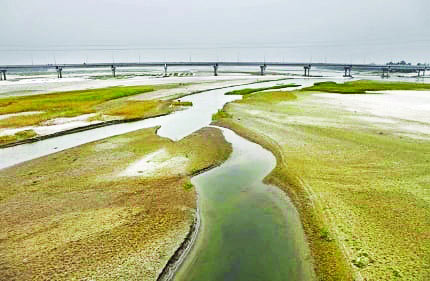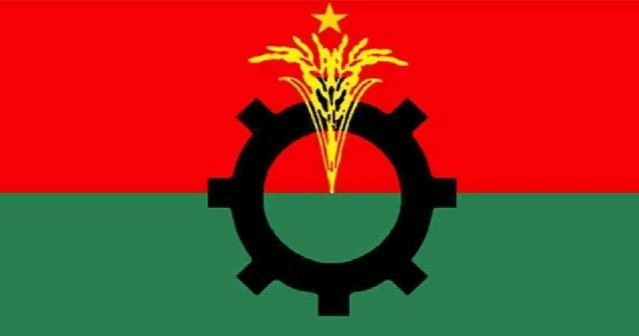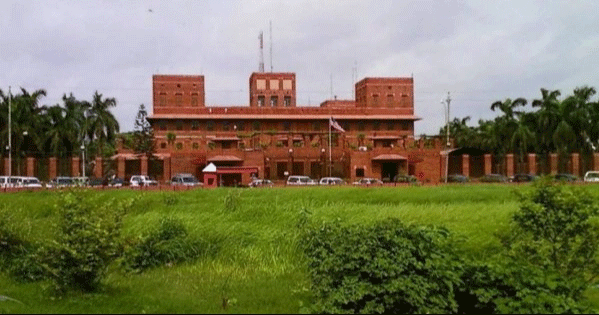Padma now turned into a small canal
Due to impact of Farakka
Mahfuz Emran: Several rivers, including the Padma, are dying, disappearing and adversely affecting the country’s climate. Now the name of a river written only in the pages of history is Padma. Is it a river? Can’t believe it. Padma does not have that stream why? All such questions have to be answered by any newcomer including children, teenagers, students. Vast sand dunes and thin bill of water or lake like Padma’s heritage is so endangered.
The Farakka Barrage is built on the Indian side of the long-flowing Ganges-Padma River at Farakka. Farakka Barrage was unilaterally constructed by India in 1968-1969. But India strategically did not launch the barrage immediately. Then General Yahya of 1970 of 1969 coup in Pakistan
The period of military rule and finally the independence of Bangladesh through the bloody liberation war of 1971. Still India waited and finally since India launched Farakka on April 21, 1975, the death toll continued.
There is a river, no water, there is sand, but no soil can be found anywhere. As a result, it is not possible to grow green crops in padma’s lap. Every year the river is getting filled with sand. Padma has lost her terrible form day by day.
In the previous years, the current of this river was weak, but this time it is not. It has become a bill. Now people can swim across the river in front of Railbazar Ghat. After a few years, instead of a boat, the river can be crossed by oxcart, bike or bicycle.
By closing all the gates of the Farakka Barrage, the river has been ruled and many rivers have been killed. One third of the country is gradually turning into desert.
Due to the abnormally low water level during the summer season, most of the tubewells in the northern region stopped producing water. There is a severe water crisis. The Farakka barrage has brought a curse to the lives of billions of people in the North-West region; The people of these areas are known as death traps.
When this barrage was launched, it was said to be a symbol of the welfare of both the nations. Today, this barrage is a disaster for the people of the country due to the reckless behavior of the neighboring state Bharat. By unilaterally withdrawing water, India has kept its ports, agriculture, irrigation and power generation systems running, but has pushed the country’s agriculture, shipping, environment and livelihood towards a dire situation.
There have been many discussions, measurements and observations on the distribution of Padma water at different times. The agreement has been reached, there has been a lot of discussion and criticism in the parliament about the agreement. But the fate of Bangladesh never got water as per the agreement. But water has come to Parliament, television, radio, print media, online newspapers, telephone. As a result, India is unilaterally withdrawing the water of not only Padma but also 54 rivers. As a result, the rivers are dying.
As the Padma River dies, the tributaries Baral, Marabaral, Narod, Muchakhan, Ichamati, Chiknai, Nagar, Dhalai, Garai, Mathabhanga, Hisla, Kajla, Chitra, Sagorkhali, Chandana, Kapotaksha are dying. Kaliganga, Belawat these rivers have disappeared. Although there is water in these rivers for a few days during the monsoon season, they remain waterless almost throughout the year. Moreover, with the death of these rivers, both sides have been illegally occupied.
The so-called people of the government party, such as sand hoarders, TR gore, tender birds, wheat hoarders in government food warehouses, Khas pond hoarders, they openly lowered dredgers, carts, trucks, lorries and carried sand from the river to carry out various construction works including brick kilns, filling, along the banks of various rivers including Padma, It is destroying the dam built worth crores of rupees. The rivers of the country have become so endangered that now the names of these rivers are on the pages of books or maps.
Adverse effects on climate. One of the main causes of death is Farakka Dam. Maulana Abdul Hamid Khan Bhasani conducted the Farakka Long March against the Farakka Barrage, considering the deadly consequences of the barrage. Bangladesh, being a low-lying country and relatively much smaller than India, could never articulate their grievances. Farakka Barrage is not an upstream water withdrawal project. This is a complete change in the course of an international river that has been flowing for hundreds of thousands of years, which is against international law.
Like every year, there have been floods in different areas of the country. In some areas there have been multiple phases. Flooding was inevitable. Numerous houses and structures have been destroyed by flood and river erosion. Roads, embankments have been damaged. Crops are destroyed. Millions of people have suffered and suffered due to flood and river erosion.
Many people have lost their houses and lands and become street beggars and there are some exceptions. While there have been floods in various areas, some areas have been experiencing periods of drought and drought. According to experts, the reason for this discrepancy is climate change.
Bangladesh is more vulnerable to climate change than many other countries in the world. Rainfall and non-rainfall at the same time in the same country is an impact of climate change. It has been observed that, where rain has occurred, it has been very heavy. Where it didn’t happen, it didn’t happen at all. This has never been seen in the past.
In the past, we see that other irrigation projects including Ganga-Kapotaksha irrigation scheme dependent on Padma water, Teesta irrigation scheme dependent on Teesta water could only provide irrigation facilities to a small part of their command area. Most of the land remains out of irrigation facilities. The owners of the land can cultivate it as they like, but if they can’t, the land remains fallow.
Thus, cultivation in irrigated areas is severely disrupted every year and production potential cannot be utilised. There is no opportunity to use the river water for irrigation in the riverside areas, the river becomes dry. Apart from this, the irrigation system which is developed depending on the ground water is also disrupted in many cases. Due to excessive water extraction, the groundwater level is no longer at its previous level, it has gone down a lot. Day by day the level of cheese is going down. Sometimes there is not enough water. What is found is also mixed with arsenic or other harmful substances, which are very harmful to crops.
It can be said that the cultivation of crops in the dry season is becoming increasingly dangerous and impossible. Due to the drying up of the river, when the ground water is under pressure, there is no water in the canals, reservoirs, ponds. There is a cry for water across the country. Not only the crop production is disrupted and damaged, but there is also a severe shortage of potable and usable water. This water shortage in the land of water is both unimaginable and alarming.
No one knows why the country and its people have fallen into this dangerous situation. First of all, rivers, canals, reservoirs, ponds and ponds have filled up and lost their water capacity. This process is ongoing.
Hundreds of rivers in the country now become victims of water scarcity during the dry season as India diverts water by constructing numerous dams and barriers upstream. Due to the Indian ambition to dry up Bangladesh without providing water, the river has lost its normal flow and is steadily moving towards death.
Hundreds of small rivers have already disappeared from the map. The crisis of existence of big rivers is also getting more and more acute. First of all, I have said that Bangladesh is a downstream country, India is diverting water by building the Farakka Dam without caring about the upstream country’s policy of not doing something that harms the downstream country.
Although there have been two agreements with India on the distribution of Ganga water, Bangladesh has not received the water according to the agreement. The ongoing 30-year agreement does not guarantee Bangladesh’s equitable access to water. As a result, water deprivation has increased. Open statement of India’s West Bengal, “During the dry season, the flow of Teesta water is so low that it does not meet the needs of West Bengal, how will we provide water to Bangladesh?”
According to experts, it is imperative to restore the navigability of rivers through extensive dredging and turn all rivers into water reservoirs. At the same time Ganga barrage needs to be constructed on an urgent basis. People of this country have been hearing about the construction of Ganga barrage for decades. The barrage is yet to be taken to the construction stage. Although the current government has been repeatedly talking about the construction of Ganga barrage, now it is heard that the government is in a dilemma due to India’s opposition. It has been reported that the government wants to build the Ganga barrage with India’s cooperation. There was no result.
President Joe Biden tests positive for COVID-19 while campaigning in Las Vegas, has ‘mild symptoms’
International Desk: President Joe Biden tested positive for COVID-19 while traveling Wedne…








